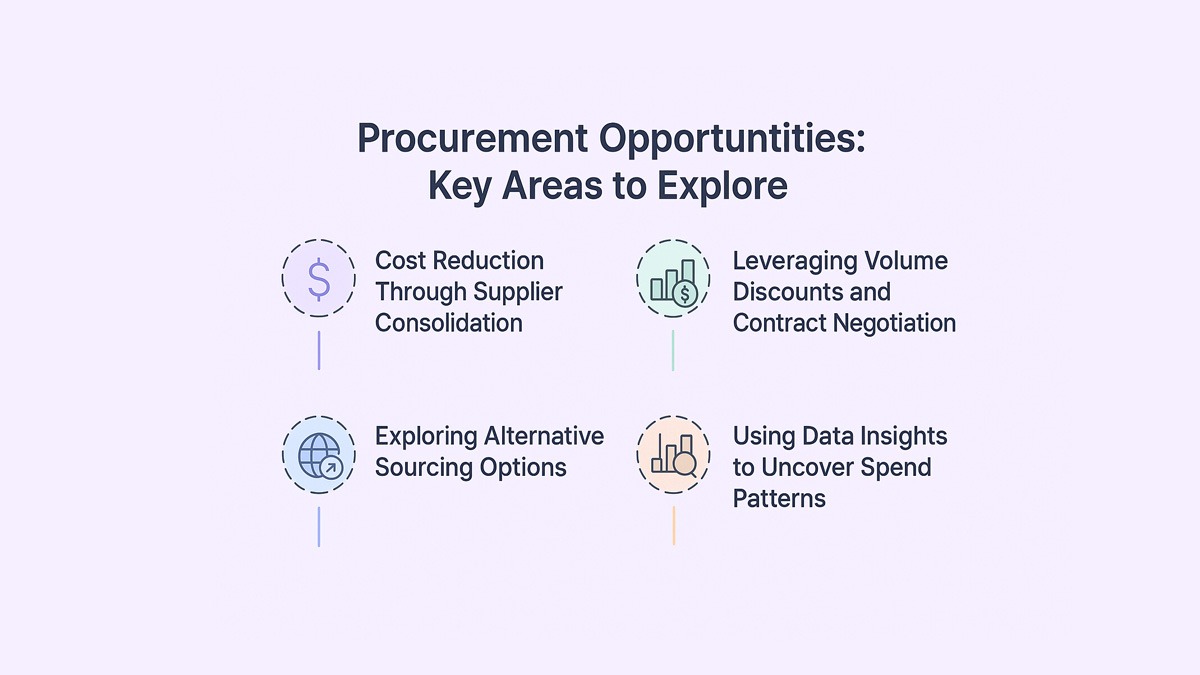

How to Conduct Procurement Opportunity Analysis & Assessment In 2025?

How to Conduct Procurement Opportunity Analysis & Assessment In 2025?
Learn how to uncover hidden savings and drive value with procurement opportunity analysis.


Imagine walking past thousands of dollars in savings every quarter - simply because no one spotted the opportunity. That’s what happens when procurement functions operate in reactive mode. In today’s economy, where budgets are tighter and CFOs expect clear ROI, procurement can’t afford to just “buy smart.” It needs to analyze smarter - identifying hidden potential and unlocking value before the PO is even created.
What Is Procurement Opportunity Analysis?
Procurement opportunity analysis is the process of identifying areas within your procurement operations that offer potential for improvement, cost savings, or added value. It focuses on surfacing inefficiencies, pricing gaps, or overlooked contracts - so teams can make smarter, more proactive decisions.
Why Procurement Needs Opportunity-Focused Analysis?
Procurement opportunity analysis isn’t a “nice to have” - it’s how modern teams move from cost centers to strategic value drivers. Here are key reasons why it matters now more than ever.
1. Improves Strategic Spend Allocation
Without a clear understanding of opportunity areas, procurement teams risk misallocating spend. Opportunity-focused analysis ensures that resources go toward categories and vendors that offer the highest return - financially and operationally.
2. Uncovers Hidden Savings Opportunities
Often, major cost-saving potential lies buried in indirect spend, overlooked contracts, or under-leveraged vendor relationships. Reviewing third-party spend can highlight underused or duplicate tools. With the right analysis framework, these hidden opportunities become visible and actionable.
3. Reduces Procurement Inefficiencies
Fragmented procurement processes lead to duplicated efforts, missed renewals, and reactive buying. An opportunity-first lens helps streamline procurement workflows and target areas with the most friction or redundancy.
4. Strengthens Supplier Relationships
By identifying opportunities for strategic partnerships or better terms, procurement teams can shift from transactional vendor management to long-term, collaborative supplier engagement. Strong supplier management also improves contract compliance and issue resolution.
5. Increases Procurement’s Influence on Business Strategy
Opportunity analysis connects procurement decisions to broader business goals - like entering new markets, improving resilience, or supporting sustainability. It’s how procurement earns a seat at the strategy table.
Key Areas to Explore During Procurement Opportunity Analysis
Procurement opportunity analysis isn’t about boiling the ocean - it’s about knowing where to look first. The goal is to identify the most impactful, achievable improvements. Below are four core areas where value often hides in plain sight.

1. Cost Reduction Through Supplier Consolidation
Too many suppliers doing the same thing? That’s not agility - it’s inefficiency. By consolidating vendors within a category, companies can negotiate better rates, reduce administrative overhead, and strengthen relationships with preferred suppliers. This also contributes to lowering overall overhead costs. Fewer contracts also mean fewer chances for things to slip through the cracks.
2. Leveraging Volume Discounts and Contract Negotiation
Every purchase you make adds to your negotiation leverage - if you use that data wisely. Procurement opportunity analysis helps identify where spend volume is under-leveraged, so you can renegotiate contracts or bundle purchases for better pricing and payment terms.
3. Exploring Alternative Sourcing Options
Markets change. A vendor that made sense two years ago might no longer be the best option. Reviewing alternative suppliers - whether local, offshore, or through group buying programs - can surface better pricing, quality, or risk diversification opportunities that weren’t previously considered. These alternatives can often reduce shipping costs significantly.
4. Using Data Insights to Uncover Spend Patterns
You can’t fix what you can’t see. Analyzing historical spend data helps uncover repetitive low-value purchases, maverick spend, or inconsistent pricing. This pattern recognition is key to tightening controls, optimizing categories, and aligning procurement with finance goals.
Balancing Opportunities with Risks in Procurement
Chasing procurement opportunities without assessing risk is like sailing faster into a storm. Smart procurement leaders know that for every gain, there’s a trade-off to manage. Here’s how to keep the balance.
A) Why Every Opportunity Has a Trade-Off
A cost-saving vendor switch might reduce expenses but could introduce quality or delivery risks. Speeding up approvals could improve agility, but may compromise compliance. Opportunity analysis must always include an honest look at potential downsides. A cost-benefit analysis helps balance savings goals with long-term risks.
B) Common Mistakes That Undermine Opportunity Gains
Procurement teams sometimes focus too narrowly on cost. They might overestimate savings from a supplier switch without factoring in onboarding costs, switching friction, or long-term service issues. Another misstep? Acting on incomplete data - leading to short-term wins but long-term pain.
C) How to Evaluate and Mitigate Procurement Risks
Use a risk lens alongside every opportunity - evaluating supplier stability, contractual obligations, regulatory exposure, and supply chain resilience. Involving legal, compliance, and finance stakeholders early ensures risks are flagged and mitigated before contracts are signed. Better inventory management can also reduce last-minute purchases and maverick spend.
D) Case Examples of Balanced Procurement Strategy
Consider a company that consolidated IT vendors to save $500K - but did so in phases, piloting with low-risk departments first. Or a business that negotiated volume discounts only after stress-testing supplier capacity to handle larger orders. These aren’t just wins - they’re sustainable wins.
Tools and Techniques for Effective Procurement Opportunity Analysis
Great analysis doesn’t come from gut feeling - it comes from the right data and tools, working together. These solutions help procurement teams move from scattered spreadsheets to sharp, insight-driven strategies. eProcurement software centralizes approvals, contract workflows, and vendor communications.

1. Spend Analytics Platforms and Dashboards
Modern spend analytics tools consolidate data across departments, categories, and vendors - creating a single source of truth. With filters for supplier, region, time period, and more, teams can slice and dice spend data to uncover outliers, savings potential, and leakage areas. This level of granularity directly supports cost optimization efforts.
2. Category Intelligence and Market Benchmarks
Knowing your internal spend is half the puzzle. The other half? Understanding what others are paying. Benchmarking tools provide market-rate insights, category trends, and supplier scorecards. They also help procurement teams stay ahead of shifting market trends. Market research can uncover new sourcing options and pricing models. They arm procurement teams with leverage to negotiate better deals and avoid overpaying. Market intelligence strengthens negotiation leverage across categories.
3. Forecasting Tools for Scenario Planning
Should you lock in pricing now or wait? What happens if you switch vendors in Q2? Forecasting and scenario-planning tools help procurement teams model the downstream impact of different decisions - be it cost, risk, or timing. That clarity turns hesitation into confident action.
4. AI and Automation in Opportunity Identification
AI can scan thousands of line items, contracts, and transactions faster than any human ever could. It flags anomalies, suggests consolidations, and even recommends suppliers based on usage history and market data. Automation also reduces manual errors and accelerates the entire opportunity analysis process.
Building an Opportunity-Driven Procurement Roadmap
Having the insights is only half the battle. The next step? Turning them into an actionable, measurable plan. A procurement roadmap keeps efforts focused, aligned, and impactful.
1. How to Prioritize and Sequence Opportunities
Not every opportunity needs to be tackled at once. Use a simple prioritization matrix - based on potential savings, effort required, and risk - to focus on low-hanging fruit first. Then build momentum toward more complex transformations over time. A thoughtful category strategy ensures procurement effort is spent where it counts.
2. Aligning Procurement Goals with Business Strategy
Does the business want to expand into a new market? Push for sustainability? Reduce OPEX? Procurement’s roadmap should ladder up to those goals. A clear procurement strategy keeps teams aligned with evolving business needs. When the function’s targets align with company-wide strategy, it’s easier to gain buy-in and budget.
3. Engaging Finance and Cross-Functional Teams
Opportunity analysis is not a solo sport. Finance, IT, legal, and business unit leaders should all have a seat at the table. Their input strengthens the roadmap and ensures smoother execution. Plus, early collaboration prevents late-stage blockers down the line.
4. Tracking Progress with Clear KPIs and Feedback Loops
Set measurable KPIs like “% of spend under management,” “cost savings captured,” or “contract cycle time reduced.” Procurement dashboards make it easier to visualize these metrics at a glance. But don’t just track outcomes - track learnings too. Regular feedback loops help teams refine their approach and adapt the roadmap as the business evolves.
How Spendflo Helps with Procurement Opportunity Analysis
Spendflo empowers procurement and finance teams to stop chasing reactive savings and start identifying proactive opportunities - before costs pile up. With centralized spend visibility, real-time vendor intelligence, and automated renewal workflows, Spendflo surfaces hidden inefficiencies across your software stack.
From supplier consolidation insights to benchmark-backed negotiations, it transforms procurement analysis into a continuous, insight-driven advantage. The result? Faster decisions, smarter buys, and measurable ROI - without the spreadsheet chaos.
Ready to simplify procurement and start saving? Book a free demo with Spendflo today.
Frequently Asked Questions on Procurement Opportunity Analysis
What is the purpose of procurement opportunity analysis?
The goal is to identify areas in your procurement process where cost savings, efficiency gains, or value improvements are possible. It helps organizations move from reactive buying to strategic procurement planning.
How can procurement teams find cost-saving opportunities?
Teams can analyze spend data, consolidate vendors, renegotiate contracts, benchmark pricing, and evaluate underused subscriptions or services to uncover savings.
Which tools are best for procurement opportunity assessment?
Spend analytics platforms, contract management tools, forecasting models, and AI-based vendor intelligence tools are among the most effective for spotting and acting on procurement opportunities.
How often should opportunity analysis be done?
Ideally, it should be an ongoing process, but at a minimum, procurement teams should conduct a thorough opportunity analysis quarterly or before major contract renewals or budgeting cycles.
How does procurement help with performance tracking and supplier management?
Procurement teams support performance tracking by setting KPIs around supplier delivery, cost, and compliance. Strong supplier management practices ensure accountability and help build long-term, value-driven partnerships.
Why is environmental sustainability and cost-benefit analysis important in procurement decisions?
Environmental sustainability ensures that sourcing aligns with eco-conscious business goals. When combined with cost-benefit analysis, teams can make decisions that are both financially and ethically sound.
How do tools like procurement dashboards and market intelligence improve sourcing decisions?
Procurement dashboards offer real-time visibility, while market intelligence helps benchmark pricing and supplier performance. Together, they enable more informed and competitive sourcing strategies.
What role do category strategy and inventory management play in opportunity analysis?
A clear category strategy guides procurement focus, while inventory management ensures efficient resource use. Aligning both helps reduce waste and optimize spending.
How does market research and supply chain consulting enhance procurement planning?
Market research uncovers trends and pricing benchmarks, while supply chain consulting provides expert insights to improve procurement workflows and vendor decisions.










.png)




.png)










.avif)





